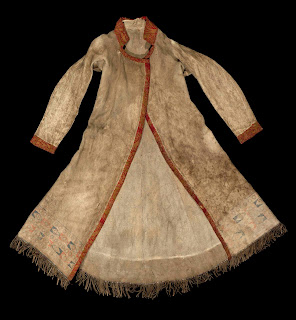A hide coat in the collections
of the Pitt Rivers Museum has been sparking a great deal of interest lately.
Obtained from a local Oxford dealer of 'antiquities' in 1906, this amazing coat
is in what we believe is traditionally tanned moose-hide, with stylised painted
designs around the hem, porcupine quillwork on the back, and a flamboyant wool
brocade facing.
 |
| PRM 1906.83.1 |
 |
| PRM 1906.83.1 back |
The coat is cut in a style
reminiscent of a banyan, a type of garment brought back to Britain from India
in the eighteenth century and popularized as a comfortable, warm indoor garment.
This makes it a garment of
multiple cultural affiliations. Did a British man bring a cloth banyan to
Hudson’s Bay and have it reworked in hide for wearing inside a cold, drafty fur
post? The coat’s quillwork and moose-hide remind us of the cross-cultural
marriages and creative hybridity at the heart of fur trade society in what is
now Canada.
To better understand the coat’s
cut and its relationship to other European men’s garments of the early 19th
century, PRM has had several students with textile and fashion expertise create
a pattern from the original garment. The latest version, by Charlotte Linton,
has refined earlier attempts and will now be duplicated so that we can send the
pattern to costume experts and to First Nations seamstresses. Cross-cultural
objects require cross-cultural research methodologies!
 |
| Sewing pattern for PRM 1906.83.1 by Charlotte Linton |